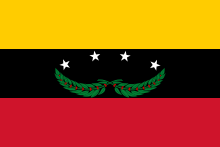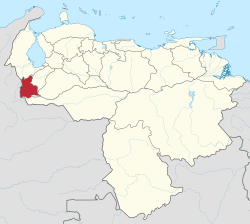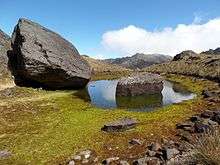Táchira
Táchira State (Spanish: Estado Táchira, IPA: [esˈtaðo ˈtatʃiɾa]) is one of the 23 states of Venezuela. The state capital is San Cristóbal.

Táchira | |
|---|---|
| Táchira State Estado Táchira (Spanish) | |
 Flag  Coat of arms | |
| Anthem: "Himno del Estado Táchira" | |
 Location within Venezuela | |
| Coordinates: 7.94°N 72.12°W | |
| Country | Venezuela |
| Created | 1899 |
| Capital | San Cristóbal |
| Government | |
| • Body | Legislative Council |
| • Governor | Laidy Gómez (2017–present) |
| • Assembly delegation | 7 |
| Area | |
| • Total | 10,812 km2 (4,175 sq mi) |
| Area rank | 16th |
| 1.2% of Venezuela | |
| Population (2011 census est.) | |
| • Total | 1,168,908 |
| • Rank | 9th |
| 4.5% of Venezuela | |
| Time zone | UTC-04:00 (VET) |
| ISO 3166 code | VE-S |
| Emblematic tree | Pino Criollo, or Laso (Prumnopitys montana) |
| Website | www |
Táchira State covers a total surface area of 10,812 square kilometres (4,175 sq mi) and as of the 2011 census, had a population of 1,168,908. At the end of the 19th century, Táchira State was where oil was discovered in Venezuela. It was exploited for many years. Currently, its main economic revenues come from the production of coffee and pineapple. The cattle and agricultural activities play an important role in Táchira's economy. There is also a strong industrial sector which focuses on the processing of potato, sugar, milk, and cheese and the production of textiles.
Táchira State is one of the three Venezuelan Andean states (the other two are Mérida and Trujillo). This state borders Zulia State to the north, Barinas and Mérida States to the east, Apure and Barinas States to the south, and Colombia (Norte de Santander Department) to the west.
History
Táchira State plays an important role in the early parts of Venezuelan history. This state produced more presidents than any other state during the 20th century: Cipriano Castro, Juan Vicente Gómez, Marcos Pérez Jiménez, Isaías Medina Angarita, Eleazar López Contreras, Carlos Andrés Pérez, and Ramón José Velásquez.

At the end of the 19th century, the people of Táchira State were tired of being left out of the main country's decisions. Consequently, a group of men decided to start a revolution called the "Revolución Restauradora" (The Restorative Revolution). The idea was to take power and enhance the importance of the Andean Region in the country. It was led by Cipriano Castro and was successful.
Until the start of the 20th century, it was highly difficult traveling between Táchira State and others and even within the state itself. This condition led to cultural differences between the people of Táchira and those from the rest of Venezuela. The former were more influenced by Colombian culture, a more accessible region through Norte de Santander province.
Tourism
During January the Capital city of San Cristóbal celebrates its fiesta, which is recognized nationally for its industrial, commercial and agricultural exhibitions. During this time there are bull-fights, events, parties, and a number of artists come to have their shows.[1]
Geography
Táchira State is located in the Andes. Its highest point is La Montaña el Pulpito, which about 3995 meters above the sea level. Táchira's population is mainly located in San Cristóbal, the most important and prosperous city of this state. Tariba, Rubio, Colon, and La Grita are also other important urban centers in this state.
It has international borders with Colombia in the west and south with Norte de Santander Department. Zulia and Mérida States lie to the north, and Barinas and Apure States lie to the east.
The main peaks are:[2]
- The Pulpit: 3,912 m
- Moor Battalion: 3,507 m
- The Tama: 3,450 m
- Moor La Negra: 3,450 m
- Moor The Zumbador: 2,850 m
Government and politics
Like other states, the structure of the government of Táchira is laid out in the Constitution, the highest law in the state.
The Governor of Táchira is in charge of the government and administration, serves for a four-year term and can be re-elected to an additional term only immediately and only once.
The state legislature is made up of a single body, the Legislative Council. It has the power to pass the state's Budget Law.
Like the other 23 federal entities of Venezuela, the State maintains its own police force, which is supported and complemented by the National Police and the Venezuelan National Guard.
Municipalities and municipal seats
- Andrés Bello (Cordero)
- Antonio Romulo Costa (Las Mesas)
- Ayacucho (Colón)
- Bolívar (San Antonio del Táchira)
- Cárdenas (Táriba)
- Córdoba (Santa Ana del Táchira)
- Fernández Feo (San Rafael del Piñal)
- Francisco de Miranda (San Jose de Bolivar)
- García de Hevia (La Fría)
- Guasimos (Palmira)
- Independencia (Capacho Nuevo)
- Jauregui (La Grita)
- José María Vargas (El Cobre)
- Junín (Rubio)
- Libertad (Capacho Viejo)
- Libertador (Abejales)
- Lobatera (Lobatera)
- Michelena (Michelena)
- Panamericano (Coloncito)
- Pedro María Ureña (Ureña)
- Rafael Urdaneta (Delicias)
- Samuel Dario Maldonado (La Tendida)
- San Cristóbal (San Cristóbal)
- San Judas Tadeo (Umuquena)
- Seboruco (Seboruco)
- Simón Rodríguez (San Simon)
- Sucre (Queniquea)
- Torbes (San Josecito)
- Uribante (Pregonero)
Population
See also
References
| Wikimedia Commons has media related to Táchira. |
- http://www.visitatachira.com
- Geografía de Táchira
- "Resultado Básico del XIV Censo Nacional de Población y Vivienda 2011 (Mayo 2014)" (PDF). Ine.gov.ve. p. 29. Retrieved 8 September 2015.